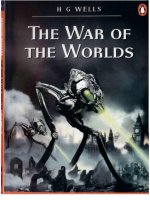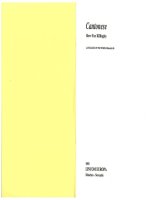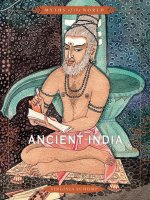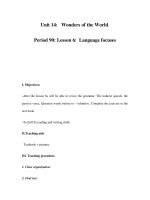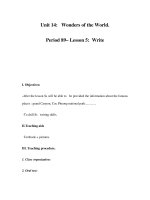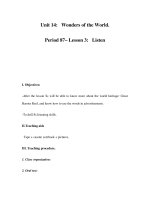ancient india (myths of the world)
Bạn đang xem bản rút gọn của tài liệu. Xem và tải ngay bản đầy đủ của tài liệu tại đây (14.64 MB, 97 trang )
Final Myths/India cover_ 11 / 11 / 2008
MCC:Myths Of The World - Ancient India - 26812
CPL1108-21 / 4272 ~CVR
ANCIENT INDIA
MCC:Myths Of The World - Ancient India - 26812
CPL1108-21 / 4272
Final Myths-India interior_ 11/11/08 3:31 PM Page 1
MCC:Myths Of The World - Ancient India - 26812
CPL1108-21 / 4272
Final Myths-India interior_ 11/11/08 3:31 PM Page 2
MCC:Myths Of The World - Ancient India - 26812
CPL1108-21 / 4272
Final Myths-India interior_ 11/11/08 3:31 PM Page 3
A
For MFN Chris Schomp
A
The author would like to thank George M. Williams, Professor Emeritus,
Historian of Religion in India, California State University, Chico, for his
valuable comments and careful reading of the manuscript.
Benchmark Books Marshall Cavendish 99 White Plains Road Tarrytown, New York 10591
www.marshallcavendish.com Text copyright © 2010 by Marshall Cavendish Corporation
All rights reserved. No part of this book may be reproduced or utilized in any form or by any means elec-
tronic or mechanical, including photocopying, recording, or by any information storage and retrieval system,
without permission from the copyright holders. All Internet sites were available and accurate when this book
was sent to press.
LIBRARY OF CONGRESS CATALOGING-IN-PUBLICATION DATA: Schomp, Virginia.
Ancient India / by Virginia Schomp. p. cm. — (Myths of the world) Summary: “A retelling of several impor-
tant ancient Indian myths, with background information describing the history, geography, belief systems,
and customs of the people of India”—Provided by the publisher. Includes bibliographical references and
index. ISBN 978-0-7614-4
640
-8 1. Mythology, Hindu. 2. Buddhist mythology. I. Title. BL1216.S37 2009
294.5’13—dc22 2008034952
Images provided by Rose Corbett Gordon, Art Editor of Mystic CT, from the following sources:
Pages 1, 46, 84: Werner Forman/Art Resource, NY; pages 2-3, 22, 58: Private Collection/Bridgeman Art Library;
page 6: Frédéric Soltan/Corbis; page 7: The Art Archive/Private Collection/Eileen Tweedy; pages 8, 28-29: The
Art Archive/Wat Phra Keo, Royal Palace, Bangkok/Francoise Cazanava; pages 10-11: The Pierpont Morgan
Library/Art Resource, NY; page 12: Victoria & Albert Museum/Bridgeman Art Library; page 15: National Army
Museum, London/Bridgeman Art Library; page 17: Scala/Art Resource, NY; pages 18, 21: Bridgeman Art
Library; page 19: The Art Archive/Musée Guimet Paris/Gianni Dagli Orti; page 24: The British Library/Topham-
HIP/The Image Works; pages 25, 44: The Art Archive/Victoria & Albert Museum/Sally Chappell; page 27:
Balawaste, National Museum of India, New Delhi/Bridgeman Art Library; pages 30, 32: Freud Museum,
London/Bridgeman Art Library; pages 33, 60, 64: Victoria & Albert Museum/Art Resource, NY; page 34: The
Art Archive/British Library; page 35: Artmedia/Heritage-Images/The Image Works; pages 36, 38: Chandigarh
Museum, Punjab/Bridgeman Art Library; page 39: Private Collection, Archives Charmet/Bridgeman Art Library;
page 40: Francis G. Mayer/Corbis; page 41: Angelo Hornak/Corbis; page 43: Stapleton Collection/Corbis; pages
47, 49, 89: Dinodia/The Image Works; pages 50, 69, 74: Mary Evans Picture Library/The Image Works; pages
52, 62: The Metropolitan Museum of Art/Art Resource, NY; page 53: Topham/The Image Works; page 55: ©The
British Library Board; pages 56, 89: World History/Topham/The Image Works; page 65: Baroda Museum,
Gujaret/Bridgeman Art Library; page 66: Museum of Fine Arts, Boston/Bridgeman Art Library; pages 68, 73:
Brooklyn Museum/Corbis; page 70: The Art Archive/Victoria & Albert Museum/Eileen Tweedy; pages 76, 78, 88:
DPA/SSK/The Image Works; page 79: Stapleton Collection/Bridgeman Art Library; page 82 top: The LuEsther T.
Mertz Library, NYBG/Art Resource, NY; page 82 bottom: HIP/Art Resource, NY
Printed in Malaysia
135642
EDITOR: Joyce Stanton
PUBLISHER: Michelle Bisson
PHOTO RESEARCH : Rose Corbett Gordon
ART DIRECTOR: Anahid Hamparian
SERIES DESIGNER: Michael Nelson
MAP: Mike Reagan
Front cover:
A priest transcribes one of the sacred texts of India’s oldest and most
enduring faiths, Hinduism.
Half-title page:
One of the fearsome demons of Indian mythology
Title page:
Vishnu reclines on a serpent, with his divine wife Lakshmi at his feet.
Back cover:
Agni, the two-headed god of fire, rides on a ram.
MCC:Myths Of The World - Ancient India - 26812
CPL0409-061 / 4237
Final Myths-India interior_ 4/9/09 4:23 PM Page 4
the magic of myths 6
Part 1
MEET THE ANCIENT INDIANS
A Sacred Land 13
A Long and Glorious History 16
The Growth of Hinduism 20
The Hindu Gods and Goddesses 22
Hindu Beliefs and the Caste System 23
The Ideal Path 26
Part 2
TIMELESS TALES OF ANCIENT INDIA
The Origins of the World: Brahma Emerges from the Lotus Flower 31
The Fifth Incarnation of Vishnu: Vamana and the Three Steps 37
The Seventh Incarnation of Vishnu: The Ramayana 45
Faces of the Great Goddess: Durga Slays the Buffalo Demon 59
The Remover of Obstacles: ow Ganesha Got is Elephant ead 67
Stories of the Buddha: Jataka Tales 77
GLOSSARY 87
SOURCES OF THE MYTHS 88
TO FIND OUT MORE 90
SELECTED BIBLIOGRAPHY 91
NOTES ON QUOTATIONS 92
INDEX 93
contents
MCC:Myths Of The World - Ancient India - 26812
CPL1108-21 / 4272
Final Myths-India interior_ 11/11/08 3:31 PM Page 5
6
ANCIENT INDIA
EVERY ANCIENT CULTURE HAD ITS MYTHS.
These timeless tales of gods and heroes give us a window into the
beliefs, values, and practices of people who lived long ago. They can
make us think about the BIG QUESTIONS that have confronted
humankind down through the ages: questions about human nature,
the meaning of life, and what happens after death. On top of all that,
myths are simply great stories that are lots of fun to read.
What makes a story a myth? Unlike a narrative written by a partic-
ular author, a myth is a traditional story that has been handed down
from generation to generation, first orally and later in written form.
Nearly all myths tell the deeds of gods, goddesses, and other divine
beings. These age-old tales were once widely accepted as true and
sacred. Their primary purpose was to explain the mysteries of life and
the origins of a society’s customs, institutions, and religious rituals.
the magic
of
myths
Above:
The
elephant-
headed god
Ganesha is
worshipped
as a remover
of obstacles.
MCC:Myths Of The World - Ancient India - 26812
CPL1108-21 / 4272
Final Myths-India interior_ 11/11/08 3:32 PM Page 6
THE MAGIC of MYTHS
7
It is sometimes hard to tell the difference between a myth and a
heroic legend. Both myths and legends are traditional stories that may
include extraordinary elements such as gods, spirits, magic, and mon-
sters. Both may be partly based on real events in the distant past.
However, the main characters in legends are usually mortals rather
than divine beings. Another key difference is that legends are basically
exciting action stories, while myths almost always express deeper
meanings or truths.
Mythology (the whole collection of myths belonging to a society)
played an important role in ancient cultures. In very early times, peo-
ple created myths to explain the awe-inspiring, uncontrollable forces
of nature, such as thunder, lightning, darkness, drought, and death.
Krishna (the
blue god at
the left)
prepares to
battle a giant
serpent.
MCC:Myths Of The World - Ancient India - 26812
CPL1108-21 / 4272
Final Myths-India interior_ 11/11/08 3:32 PM Page 7
8
ANCIENT INDIA
Even after science began to develop more rational explanations for
these mysteries, myths continued to provide comforting answers to
the many questions that could never be fully resolved. People of nearly
all cultures have asked the same basic questions about the world
around them. That is why myths from different times and places can
be surprisingly similar. For example, the peoples of nearly every
ancient culture told stories about the creation of the world, the origins
of gods and humans, the cycles of nature, and the afterlife.
Mythology also served ancient cultures as instruction, inspiration,
and entertainment. Traditional tales offered a way for the people of a
society to express their fundamental beliefs and values and pass them
down to future generations. The tales helped preserve memories of a
civilization’s past glories and held up examples of ideal human quali-
ties and conduct. Finally, these imaginative stories provided enjoy-
Hanuman the
monkey god
speaks with
Rama, the
blue-skinned
prince who is
a form of the
great god
Vishnu.
MCC:Myths Of The World - Ancient India - 26812
CPL1108-21 / 4272
Final Myths-India interior_ 11/11/08 3:32 PM Page 8
THE MAGIC of MYTHS
9
ment to countless listeners and readers in ancient times, just as they
do today.
The MYTHS OF THE WORLD series explores the mythology of some
of history’s greatest civilizations. Each book opens with a brief look at
the culture that created the myths, including its geographical setting,
political history, government, society, and religious beliefs. Next
comes the fun part: the stories themselves. We have based our
retellings of the myths on a variety of traditional sources. The new ver-
sions are fun and easy to read. At the same time, we have strived to
remain true to the spirit of the ancient tales, preserving their magic,
their mystery, and the special ways of speech and avenues of thought
that made each culture unique.
As you read the myths, you will come across sidebars (text boxes)
highlighting topics related to each story’s characters or themes. The
sidebars in Ancient India include quoted passages from ancient hymns,
poems, and narratives. The sources for the excerpts are explained in
the Notes on Quotations on page 92. You will find lots of other useful
material at the back of the book as well, including information on
India’s sacred texts, a glossary of difficult terms, suggestions for fur-
ther reading, and more. Finally, the stories are illustrated with both
ancient and modern paintings, sculptures, and other works of art
inspired by mythology. These images can help us better understand
the spirit of the myths and the way a society’s traditional tales have
influenced other cultures through the ages.
Now it is time to begin our adventures in ancient India. We hope
that you will enjoy this journey to a land of mysterious gods and god-
desses, powerful demons, and noble heroes and heroines. Most of all,
we hope that the sampling of stories and art in this book will inspire
you to further explorations of the magical world of mythology.
MCC:Myths Of The World - Ancient India - 26812
CPL1108-21 / 4272
Final Myths-India interior_ 11/11/08 3:32 PM Page 9
MCC:Myths Of The World - Ancient India - 26812
CPL1108-21 / 4272
Final Myths-India interior_ 11/11/08 3:32 PM Page 10
MCC:Myths Of The World - Ancient India - 26812
CPL1108-21 / 4272
Final Myths-India interior_ 11/11/08 3:32 PM Page 11
MCC:Myths Of The World - Ancient India - 26812
CPL1108-21 / 4272
Final Myths-India interior_ 11/11/08 3:32 PM Page 12
13
Opposite:
A
princess and
her attendants
relax beside
one of India’s
sacred rivers.
Previous
page:
Indra,
supreme god
of the early
Indians, rides
in style on his
divine white
elephant.
I
A
SACRED LAND
A SACRED LAND
INDIA SITS ON A PENINSULA SO LARGE THAT IT IS KNOWN
as a subcontinent. The southern part of this enormous landmass juts
out into the Indian Ocean. The northern part is separated from the
rest of Asia by the Himalayan Mountains. The Himalayas are the
world’s tallest mountain range. Since ancient times the people of India
have revered these snowcapped peaks as the dwelling place of gods. In
“How Ganesha Got His Elephant Head” (page 67), we will meet the
divine daughter of the Himalayas, Parvati.
The Himalayas are just one of India’s nine major mountain
ranges. The vast subcontinent also holds a great variety of other land-
scapes. There are wooded hills, dry plateaus, arid deserts, tropical rain
forests, and narrow strips of lush green coastland. A number of rivers
flow through this varied terrain. The Indus River, in the northwest,
gave India its name. In ancient times the fertile plain of the Indus was
home to the region’s earliest known civilization. To the east is the
MCC:Myths Of The World - Ancient India - 26812
CPL1108-21 / 4272
Final Myths-India interior_ 11/11/08 3:32 PM Page 13
ANCIENT INDIA
BAY OF BENGAL
INDIAN OCEAN
ARABIAN
SEA
MILES
3000
HARAPPA
BENARES
MOHENJO
DA RO
AYODHYA
N
G
A
N
G
E
S
R
I
V
E
R
I
N
D
U
S
R
I
V
E
R
S
A
R
A
S
V
A
T
I
R
I
V
E
R
H
I
M
A
L
A
Y
A
S
LANKA
I
N
D
U
S
V
A
L
L
E
Y
MCC:Myths Of The World - Ancient India - 26812
CPL1108-21 / 4272
Final Myths-India interior_ 11/11/08 3:32 PM Page 14
Ganges, India’s holiest river. The Sarasvati River was an important
waterway in early times, but it has since dried up. Each of these sacred
rivers is associated with a goddess or god. So are thousands of other
rivers, lakes, and pools. Today the people of India still come to their
holy waters—especially the Ganges River—to sing, pray, and ask for
the blessings of the special deities who preside there.
India has a long dry season, usually stretching from October
to May. During the summer, monsoon winds bring moisture from
the Indian Ocean, dumping heavy rains that can last for months.
The monsoons often cause devastating floods and landslides. At the
same time, farmers depend on the life-giving rains to bring water to
their crops. Ancient histories recall years when the monsoons failed,
leading to drought and starvation. According to mythology,
droughts occurred when the gods were angry or dreadful demons
captured the waters.
A
SACRED LAND
The snowcapped
Himalayas rise
from the banks
of the Ganges
River in northern
India.
15
MCC:Myths Of The World - Ancient India - 26812
CPL1108-21 / 4272
Final Myths-India interior_ 11/11/08 3:32 PM Page 15
A LONG AND
GLORIOUS HISTORY
16
I
ANCIENT INDIA
INDIA WAS HOME TO ONE OF THE WORLD’S EARLIEST
civilizations. The Indus Valley civilization began nearly five thousand
years ago in northern India and parts of present-day Pakistan and
Afghanistan. The people of this highly advanced culture raised crops
and livestock in the fertile plains of the Indus and Sarasvati rivers.
They created beautiful pottery, jewelry, and stone and metal sculp-
tures. They built splendid walled cities, including Harappa and
Mohenjo Daro. Archaeologists exploring the Indus Valley cities have
uncovered the ruins of paved streets, massive brick buildings, and a
sophisticated system of baths, toilets, and sewers. They have also
found clay seals carved with an ancient form of writing that has never
been deciphered.
Around 1700 BCE the Indus Valley civilization faded. Some histori-
ans think that natural forces such as earthquakes, floods, and droughts
may have driven settlers from their homes. Many people moved east-
MCC:Myths Of The World - Ancient India - 26812
CPL1108-21 / 4272
Final Myths-India interior_ 11/11/08 3:32 PM Page 16
A
LONG AND GLORIOUS HISTORY
17
ward, to the fertile valley of the Ganges River.
There a new civilization emerged, dominated by
the Aryans. Most modern-day scholars believe
that the Aryans were nomads from central Asia
who crossed the Himalayas to settle in northern
India. These people brought the ancient beliefs,
practices, and stories that would develop
into India’s dominant religion,
Hinduism. The first Hindu scriptures
were the Vedas, a collection of prayers
and hymns written in Sanskrit, the
language of the Aryans. The period
of Indian history from about 1500 to
500 BCE is often called the Vedic
period after these sacred texts.
Following the end of the Vedic
period,
two great empires rose and fell in India.
A warrior-king named
Chandragupta
Maurya carved out the first empire in
northern and central India around 332 BCE. Chandragupta’s grandson
Asoka brought nearly the entire subcontinent under Mauryan rule.
After completing his conquests, Asoka renounced warfare and con-
verted to Buddhism. Compared to Hinduism, Buddhism was a young
religion. It had been founded around the sixth century BCE by the
A variety of systems of dating have been used by different cultures
throughout history. Many historians now prefer to use
BCE (Before
Common Era) and
CE (Common Era) instead of BC (Before Christ) and AD
(Anno Domini), out of respect for the diversity of the world’s peoples.
This four-
thousand-year-old
statue of a man
was discovered
in the ruins of
Mohenjo Daro,
one of the great
cities of the
Indus Valley
civilization.
MCC:Myths Of The World - Ancient India - 26812
CPL1108-21 / 4272
Final Myths-India interior_ 11/11/08 3:32 PM Page 17
ANCIENT INDIA
18
Disciples of the
Buddha, founder
of the Buddhist
religion, crowd
the walls of an
ancient cave
temple in
central India.
MCC:Myths Of The World - Ancient India - 26812
CPL1108-21 / 4272
Final Myths-India interior_ 11/11/08 3:32 PM Page 18
Indian prince Siddhartha Gautama,
known as the Buddha, or “Enlightened
One.” Asoka helped spread the
Buddhist ideals of nonviolence and
charity throughout much of central Asia.
After Asoka’s death the Mauryan
Empire declined. Centuries of foreign
invasions and internal divisions followed.
Then, in the early fourth century CE,
Chandra Gupta I* founded ancient India’s
second mighty empire. Under the Gupta
Empire, India enjoyed a golden age of peace
and prosperity. Art, literature, mathematics, and science flourished.
Several different religions, including Buddhism and Jainism, thrived
alongside Hinduism.
By the late fifth century invasions and rebellions had weakened the
Gupta Empire. Around 550 CE India divided into a mosaic of smaller
kingdoms. Over the centuries that followed, large areas of the sub-
continent would be dominated by a series of foreign conquerors.
India’s culture would embrace ideas from many different peoples. At
the same time, beliefs and practices reaching back to the dawn of
Indian history would remain a vital part of everyday life.
* The names of ancient India’s kings and empires can be confusing. It may help
to remember that Chandragupta, the name of the founder of the Mauryan
Empire, is written as one word, while Gupta is usually a separate word in the
names of the kings of the Gupta Empire.
A
LONG AND GLORIOUS HISTORY
19
The Buddha
offered his
followers a path
to peace and
enlightenment.
MCC:Myths Of The World - Ancient India - 26812
CPL1108-21 / 4272
Final Myths-India interior_ 11/11/08 3:32 PM Page 19
20
ANCIENT INDIA
A
THE GROWTH
of HINDUISM
ANCIENT INDIA WAS THE BIRTHPLACE OF SEVERAL OF THE
world’s major religions. The religion that played the greatest role in
shaping Indian society was Hinduism. Today more than 800 million
people in India and other lands still practice this enduring faith.
Hinduism had no single founder. Instead, it was born out of a
blending of the beliefs of the ancient Indus Valley civilization and
India’s Aryan settlers. Over the centuries it absorbed many new ideas
from foreign invaders and from rival religions that emerged at home.
By the golden age of the Gupta Empire, there were many different
varieties of Hinduism, embracing a wide range of beliefs and practices.
Most Hindus believe in a vast number of gods and goddesses.
During the Vedic period, the three most important deities were Agni,
god of fire; Surya, god of the sun; and Indra, god of storms and battle.
Over time a new trio rose to importance. The gods of this sacred
Hindu trinity are Brahma the creator, Vishnu the preserver, and Shiva
MCC:Myths Of The World - Ancient India - 26812
CPL1108-21 / 4272
Final Myths-India interior_ 11/11/08 3:32 PM Page 20
THE GROWTH
of
HINDUISM
21
the destroyer. The great gods are accom-
panied by many thousands of lesser
gods, spirits, and other divine beings,
each with their own powers and per-
sonalities. Ancient Hindu scriptures
explain that all the gods, greater
and lesser, are different forms of the
one Supreme God, called Brahman.
The Hindu goddesses are
regarded as different forms of
Mahadevi, the “Great Mother” or
“Great Goddess” who gave rise to all
life. Some forms of the Great Goddess,
such as Sarasvati, goddess of knowledge
and the arts, can be gentle and giving. Others
are more dangerous. In “Durga Slays the Buffalo Demon” (page 59)
and “Kali the Destroyer” (page 65), we will meet two of Hinduism’s
most bloodthirsty warrior goddesses.
The gods and goddesses are opposed by a host of evil spirits,
ghosts, and monsters. Most fearsome of all are the asuras (ah-SOO-
rahz), or demons, who dwell in the underworld. The asuras constantly
battle the gods for control of the universe.
Stories of the gods and goddesses have been told and retold many
different ways through the ages, both orally and in the sacred Hindu
texts. Elements of the stories often change in the retellings. Indian lis-
teners and readers have never been bothered by the inconsistencies.
For them, the many versions of these ancient tales are like variations
on a piece of music—all enjoyable and all true from a mythological
point of view.
Vishnu the
preserver holds
objects symbol-
izing his divine
powers and his
role as the
protector of
humanity.
MCC:Myths Of The World - Ancient India - 26812
CPL1108-21 / 4272
Final Myths-India interior_ 11/11/08 3:32 PM Page 21
22
ANCIENT INDIA
The ancient Hindus worshipped thousands of different gods and goddesses.
Here are a few of their most important deities.
the hindu gods
and
goddesses
AGNI God of fire
DURGA Warrior goddess; slayer of demons
GANESHA Elephant-headed god of wisdom,
wealth, and good fortune;
remover of obstacles
INDRA Early king of the gods; god
of storms and battle
KALI Goddess of destruction
KRISHNA Ninth and most important
incarnation of Vishnu
LAKSHMI Goddess of good fortune; wife
of Vishnu
PARVATI Goddess of the mountain; wife
of Shiva
RAMA Seventh incarnation of Vishnu
SARASVATI Goddess of knowledge and the
arts; wife of Brahma
SURYA God of the sun
VARUNA God of water, rain, and fertility
VAYU God of the wind
Shiva the
destroyer
VISHNU
Preserver of
the universe
SHIVA
God of both destruction
and creation
BRAHMA
Creator of the universe; first
god of the Hindu trinity
MCC:Myths Of The World - Ancient India - 26812
CPL1108-21 / 4272
Final Myths-India interior_ 11/11/08 3:32 PM Page 22
23
A
HINDU BELIEFS
and the
CASTE SYSTEM
ACCORDING TO THE EARLIEST HINDU WRITINGS, INDIA’S
Aryan people were loosely divided into social classes, based mainly on
wealth and occupation. Over time those divisions developed into a
rigid, highly organized social system. The Indians called their system
of social classes varnas. Later European observers used the word castes.
There were four main castes. At the top of the social order were the
Brahmans, or priests. Next came the Kshatriyas, who traditionally
were government leaders and professional warriors. The Vaishya caste
was made up of farmers and merchants. The lowest caste was the
Shudras, who included servants, laborers, and craft workers. At the
very bottom of society was a group of people with no caste at all,
known as untouchables. The untouchables worked at jobs that were
considered “impure,” such as butchering animals or collecting
garbage. Within the four basic castes were thousands of subgroups, or
jatis (JAH-teez), based mainly on a family’s traditional occupation. A
HINDU BELIEFS
and the
CASTE SYSTEM
MCC:Myths Of The World - Ancient India - 26812
CPL1108-21 / 4272
Final Myths-India interior_ 11/11/08 3:32 PM Page 23
Shudra, for example, might be born into a blacksmith or tailor jati.
The caste system was rooted in two basic principles of Hinduism:
reincarnation and karma. According to Hindu beliefs, every person
has an eternal soul, which is reincarnated, or reborn, in a new body
after death. The form of rebirth depends on the individual’s karma.
Karma is the sum of all good and bad deeds that the person has per-
formed during past lives. An individual born into the privileged
Brahman class is said to have lived better past lives than someone
reborn as a Vaishya or Shudra.
In order to achieve a higher rebirth, Hindus must live according to
their dharma. Dharma is the set of duties divinely assigned to each per-
son according to his or her place in society. Around 200
CE Hindu priests
spelled out those religious and social obligations in a text called the Laws
ANCIENT INDIA
24
This nineteenth-
century painting
captures one of
the many cere-
monies that
filled the lives of
members of the
Brahman class.
MCC:Myths Of The World - Ancient India - 26812
CPL1108-21 / 4272
Final Myths-India interior_ 11/11/08 3:32 PM Page 24
